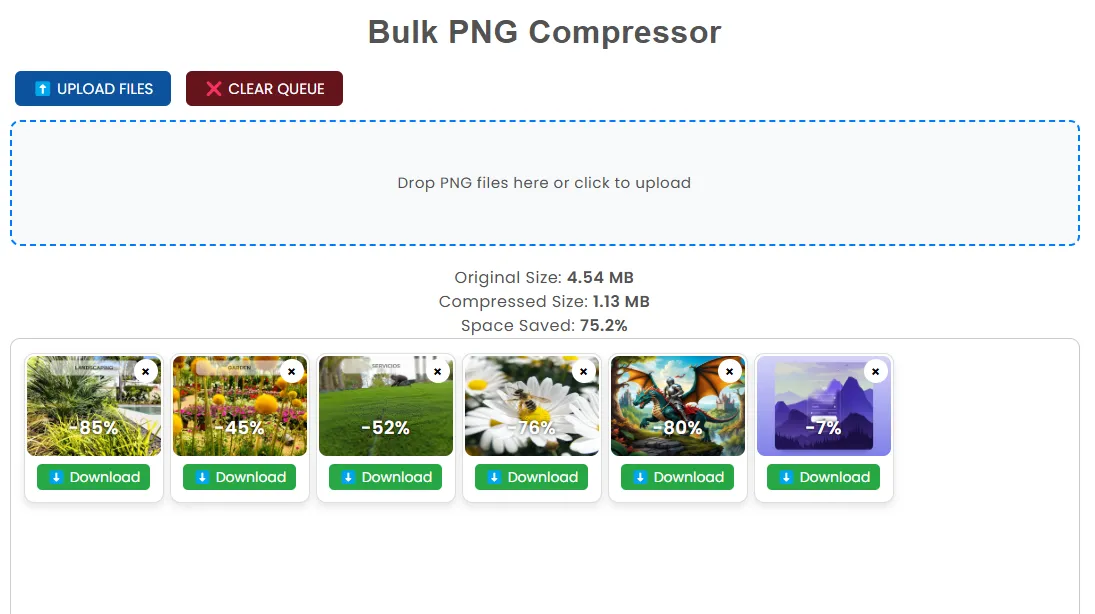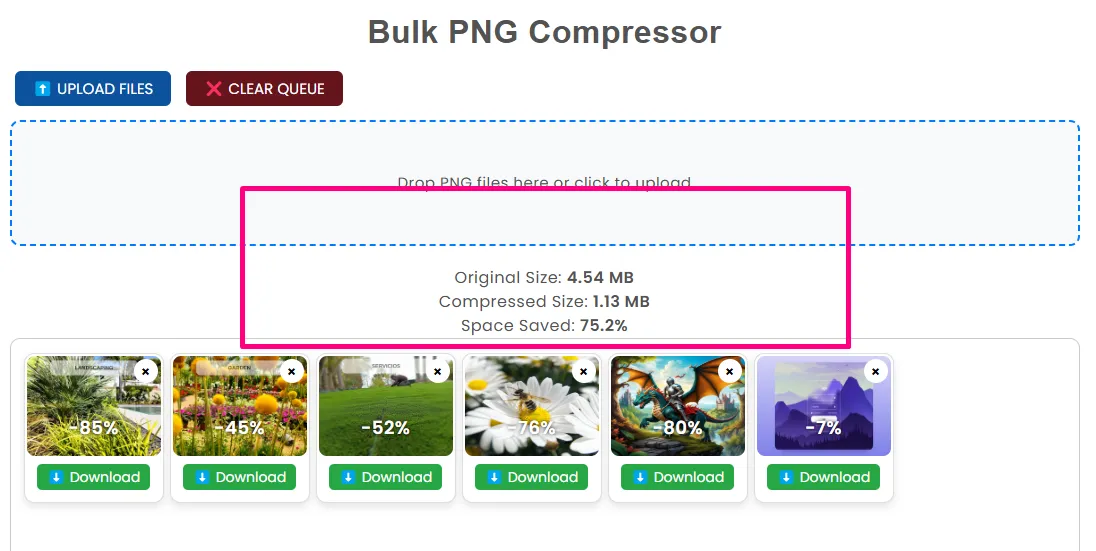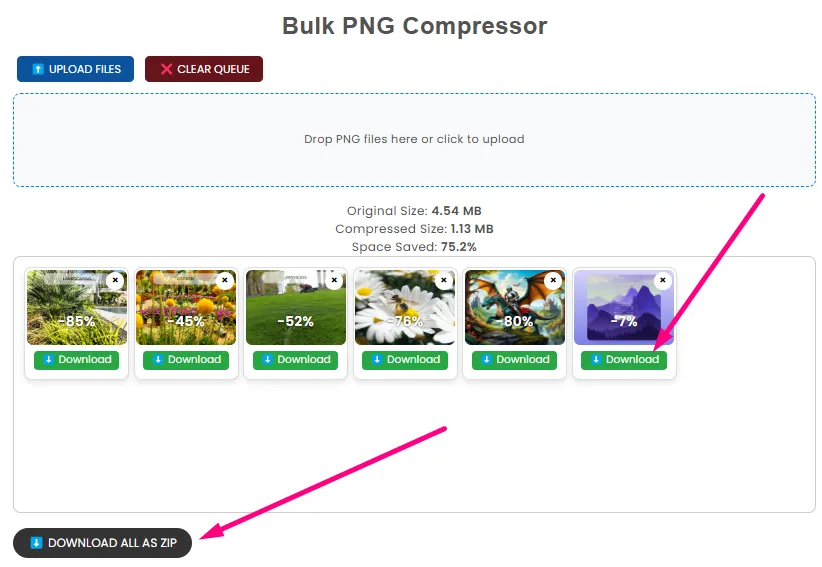Bulk PNG Compressor
PNG Bulk Compressor – Bulk Compress PNG Images
We are in the era of modernity in digital times, and optimization of images is not an amenity but a necessity for the speed, performance, and response of websites and the overall user experience. If you are compressing a collection of PNG images, particularly for web development or web design, you can save storage space and bandwidth without losing quality. That's what our PNG Bulk Compressor does, and fast, too. You may have only a few pictures to shrink, or you may have hundreds of pictures. Our tool helps you shrink your PNG pictures in bulk in seconds, so your files become web-friendly and light.
What is PNG Bulk Compression?
PNG (Portable Network Graphics) is one of the most popular image formats that makes use of lossless data compression, where the original quality of the image remains and provides file compression. Large PNG files, however, hugely increase the loading time of a web page and provide a poor user experience.
PNG Bulk Compression is a term that implies compressing a bulk of PNG images in bulk. Our tool never compresses individual images but offers you a feature to upload and compress a bulk of PNG images in bulk. It takes less space on your images without degrading the quality, so your site loads faster and enhances performance.
Benefits of PNG Bulk Compression
There are numerous benefits of PNG bulk compression:
- Faster Website Speed: Big images slow down your site. PNG image compression loads your pages quicker, so your website speed and responsiveness are improved.
- Better SEO Performance: Smoother loads improve your site's SEO. Google likes fast sites, so optimised images can boost search engine ranking.
- Less Server Space: Compressed PNG images take up less space on your server or cloud storage. This is very handy if you've got lots of images or are limited to how much space you have.
- Mobile-Friendly: Large image file sizes take up significant amounts of mobile data, causing slow loading times or even mobile timeouts. Compressed PNG images from us ensure your website is well optimized on all cell phones, smartphones, and tablets.
- Bandwidth Savings: Your site sends less data if images are smaller when the user visits your site. It saves bandwidth cost and gives a faster browser experience.
How to Compress PNG Images in Bulk
It never used to be so simple to compress bulk PNG images. reduce png size is within our grasp and is straightforward. The following are guidelines on how to compress it in a simple step-by-step process:
Step 1: Upload Your PNG Files

Press the "Upload" button and enter the PNG files that you wish to compress. Upload files at the same time, or simply drag and drop for file upload.
Step 2: Start Compression

When you have uploaded your images and settings, click "Recompress". Your files will be compressed in batches by the software.
Step 3: Optimize and Enjoy

Your images now compressed, you can now upload to your site or incorporate them into your design process. Enjoy speedy load times and improved overall performance.
Step 4: Save Compressed Files

Once compressed, save the compressed PNG images into a zip or individually, based on preference.
Why Should You Use Our PNG Bulk Compressor Tool
There are undoubtedly other png image size reducer available, but our PNG Bulk Compressor is far superior to the rest in some ways:
- Ease of Use: Our compressor is simple to use. No technical expertise or complicated process required. Just upload your files and compress them immediately.
- High Compression Levels: You will obtain one of the highest levels of compression, without in any way degrading the image quality. You can set a much higher level of compression grade to use, depending on how much file size reduction you need
- Batching: Compress hundreds, even thousands of images at a time. Bulk processing is inherent within our tool, so it is ideal for businesses or individuals who have to compress many images.
- Fast Compression: Time is money. Our software is made for fast compression, and you save time, getting back to work sooner.
- Free to Use: Free usage Our software is. Compress as many PNG images as you want, totally free.
- Private and Secure: Your privacy is important to us. The images uploaded are processed securely, and upon compression, automatically deleted from our servers.
Free and Fast PNG Bulk Compression
PNG Bulk Compressor software is free. Free if you're compressing a few images or you're compressing them in bulk. Speed also matters; the software compresses your images within seconds, and you can resume your work.
Compress PNG Images Without Losing Data or Clarity
When you compress your PNG images, sometimes data is lost. But our tool features lossless compression, so the image detail and clarity won't be compromised. You can't sacrifice the quality of the image for the sake of faster loading.
Keep High-Quality Images After Compression
One of the largest issues with image compression is loss of quality. Fear not, our PNG Bulk Compressor does not make you sacrifice that. We compress your images with advanced compression algorithms that reduce file sizes without losing your image quality. You get smaller file sizes without sacrificing the clarity in any way.
PNG Bulk Compressor Tool Features
We have some wonderful features in our PNG Bulk Compressor that make it stand out:
- Multiple Image Upload Feature: Upload numerous PNG images in a single go and compress them in batches. It is saving your precious time, particularly when handling bulk images.
- Free & Unlimited Use: Our software is free to use without any limitation on the number of images you can compress. Get to use it completely for free and without any limits, and without paying any extra fees or charges.
- No Any Cost: Unlike most other image compression software, there are no secret fees or charges for using our PNG Bulk Compressor. It's completely free.
- Positive User Experience: This tool has a pleasant interface and is simple to use and understand. Newbies or experts can easily experiment with their PNG photos in this fast-compression camp.
- Download Single or As Full in ZIP: You can download them separately or as a ZIP later, which you unzip. It is extremely handy if you have to download enormous amounts of them at once, and it saves time, too.
Start Compressing PNG Images in Bulk Now
Ready to compress images? Minimize file sizes and improve website speed today with our PNG Bulk Compressor. Fast, free, and simple. Click the button below to upload your images and begin compressing!
Thank You for Using Our Tool
We would love to hear your feedback. Your review will help us continue improving.
Please Review Us
Rate Us Now – Your Opinion Helps Us Grow!
Other Related Tools
FAQs on reduce size PNG file tool
Tabs
Of course, one can compress PNG without loss in quality. PNG has lossless compression, which shows that the images are not only shrunk in size but also remain intact with every bit of detail. Optimized for fast loading, images still look fairly celebrated.
Compress a png image does not cause loss in the quality of the image, thus it is lossless. What this means is that even though the image is viewed to be the same, it is actually much smaller because redundant data has been removed. This is one of the most definitive aspects of PNG.
The actual amount possible for compression on PNG files mostly depends on how detailed the image is. Simple, two-toned images, or even images with flat surfaces, could compress to between 50 and 70%. On the other hand, images that have so many details would tend to compress much less. Most PNGs typically end up taking 30-60% off.
Compress png photo is a lossless compression that recognizes and removes some repeated or redundant data in an image file. Filtering and DEFLATE compression are some techniques that go with reduce png file size. This commonality allows keeping intact all the details that the image had with a condensation of the file and thus reducing the file size.
PNG holds many very important merits as follows:
- Very high-quality lossless compression
- It makes transparency possible, making it an excellent candidate for use in web design graphics
- Works wonders for icons, graphics, and logos that have sharp edges
- Supported over a wide range of browsers and devices
- Retains even after editing to save its quality.
Your Rating : Good!